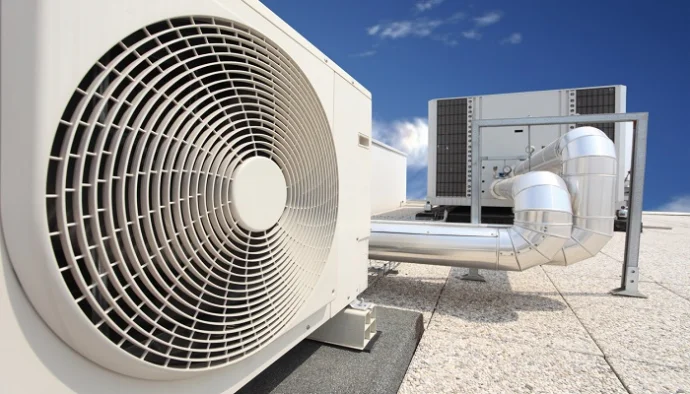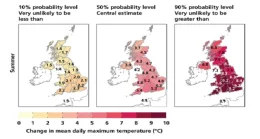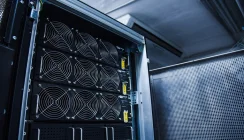How to Calculate Server Room Air Conditioner Sizes
With the UK experiencing one of the hottest summers since 1976 many server room air conditioners and datacentre cooling systems are facing extreme workloads. The issue is not the ambient temperature itself but the length of time that the higher than average temperatures have been around. For future upgrades and new system installations it may well become the norm to have to build in a ‘heatwave’ factor to prevent disruption and potential system failures. So how do you size an air conditioner for a server room or datacentre?
Cooling System Sizing Factors
The simplest view is that you list all the heat sources and install an air conditioner that will remove the heat and prevent the server room ambient temperature from going critical. The actual calculation is more complex and must take into account a number of other factors.
Heat and Energy
In any electrical installation, ‘heat’ is wasted energy and results from a work-related process. The higher the energy efficiency, the more of the power input into a system results in output. The lower the energy efficiency the higher the heat wasted.
Within a server room or datacentre environment the power consumption of the server loads can be as high as 15kW per rack. At 95% efficient this can lead to up to 0.75kW of heat per server rack that will add to the ambient temperature.
Typical heat load measurement units include:
- BTU/hour where BTU = British Thermal Unit
- Watts or Kilowatts (1kW is equal to 3412 BTUs or 1W = 3.14 BTU per hour)
- Tons per day (1 ton of cooling is equivalent to 12 thousand BTUs)
Traditionally BTU/hour has been the measurement unit of choice by Heating Ventilation and Air Conditioning (HVAC) professionals. BTU is approximately the energy needed to heat one pound of water by 1 degree Fahrenheit. 1 BTU is equal to 1,055 Joules or 252 calories or 0.293 watt-hour or the energy released from burning one match. In the IT world and especially server rooms and datacentres the trend is more towards use of Watts and kilowatts or kW as a unit of measure.
Measuring and Calculating Heat Loads
The first thing to do when calculating an air conditioning system is to audit the equipment within the room itself. The equipment list should include all electrical items within the room that will generate heat. Typical prime examples include:
- IT equipment (servers, storage units, switches and routers)
- critical power equipment including UPS systems
- existing air conditioners and cooling systems
- lighting systems
The systems and equipment should be listed by make, model and preferably serial number on an audit spreadsheet and values placed against each item where possible for BTU/hour, kW heat output, energy efficiency, electrical supply phase (single or three phase) and electrical frequency. Most often this information can be taken from operating manuals, datasheets and manufacturers websites.
For smaller server rooms this approach will help to identify the amount of heat that must be tackled by the air conditioner, referred to as the thermal load, heat load or thermal gain. The most common type of air conditioner for a server room is a wall mounted version. Ceiling suspended air conditioners are also popular where feasible.
Whether the air conditioner is installed as a single unit or part of a set to share the load, environmental monitoring is a must have. This will not only provide regular reporting on the overall ambient within the server room but also alarm when temperatures start to rise because of a failure or intermittent fault within the air conditioning system. It is also important to monitor room ambient as server rooms tend not to have automatic fire suppression equipment systems and their insulation (to comply with insurance company policies) may be higher than a typical office, leading to a greater potential for heat rise and containment.
For larger facilities a more complex cooling system will be required that could include computer room air conditioners (CRACs), computer room air handlers (CRAHs) and in-row air conditioners. Other factors to consider include:
- Building orientation in terms of shade or direct sunlight, northern or southern facing
- Room construction in terms vents, door, wall, roof top construction, ceiling height and insulation
- The number of people working within the room (typically up to 500 BTU per person)
- The floor space and use of raised access floors for air flows and ducting
- Server rack cabinet arrangements into hot/cold aisle containment
- Server utilisation
- Humidity level requirements
- Room ambient level required (See ASHRAE TC9.9 – https://tc0909.ashraetcs.org/documents/ASHRAE_TC0909_Power_White_Paper_22_June_2016_REVISED.pdf)
- External ambient temperatures
- Tier-rating and redundancy levels required (N, N+X, 2N etc)
- Energy efficiency target in terms of Power Usage Effectiveness (PUE)
- Preferred cooling technology (adiabatic/free cooling or evaporative)
- Growth factor for future expansion
Whilst there are general rules of thumb to work to when sizing a cooing system for a datacentre (CRAC unit size = 1.3 x IT load), it is more common for large installations like this to be thermodynamically modelled. This is a critical point of concern as in a server room it may be relatively easy to upgrade a poorly sized air conditioner.
In a large datacentre space, it is important to optimise both the cooling and energy efficiency so that there are no hot-spot areas and the least amount of energy is used to achieve the required ambient. Most server rooms and datacentres will look to achieve an ambient temperature around 20-25˚C with the ASHRAE standard TC9.9 used as a guideline. Potentially higher ambients can be allowed as most IT equipment will work up to 30˚C or higher but this higher temperature is detrimental to UPS batteries (if stored within the room) and uncomfortable as a working environment.
Useful BTU Cooling Formulae:
- Equipment BTU = Total wattage for all equipment x 3.5
- Lighting BTU = Total wattage for all lighting x 4.25
- Total Occupant BTU = Number of occupants x 400
- Room Area BTU = Length (m) x Width (m) x 337
- Total Heat Load = Room Area BTU + Total Occupant BTU + Equipment BTU + Lighting BTU
Note: the sample formulae are for the UK and Northern Europe in general and exclude any allowances for windows which can sometimes be found within very small server rooms.
At Server Room Environments are HVAC consultants and cooling experts manage an array of cooling projects from small air conditioners for server rooms to the large datacentre applications. One of the latest trends is to make use of adiabatic free cooling and especially in Northern Europe prior to this summer’s heatwave.
The current heatwave will subside eventually but the World in general is not getting any cooler. Weather patterns are changing and challenging traditional approaches to air conditioner and cooling system calculations. What we have provided here is a general guide and information to give you some idea of what to expect when sizing an air conditioner or cooling system. Please contact us for a specific site survey or discussion about your project with one of our HVAC engineers and project managers.


























